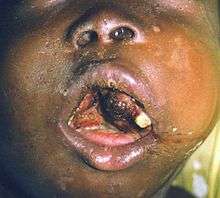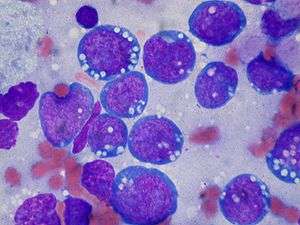Burkitt's lymphoma
| Burkitt lymphoma | |
|---|---|
|
Burkitt lymphoma, touch prep, Wright stain | |
| Classification and external resources | |
| Specialty | Hematology and oncology |
| ICD-10 | C83.7 |
| ICD-9-CM | 200.2 |
| ICD-O | M9687/3 |
| OMIM | 113970 |
| DiseasesDB | 1784 |
| MedlinePlus | 001308 |
| eMedicine | med/256 |
| Patient UK | Burkitt's lymphoma |
| MeSH | D002051 |

Burkitt lymphoma, also known as Burkitt's tumor, Burkitt's lymphoma, or malignant lymphoma, Burkitt's type, is a cancer of the lymphatic system, particularly B lymphocytes found in the germinal center. It is named after Denis Parsons Burkitt, a surgeon who first described the disease in 1958 while working in equatorial Africa.[1][2]
Classification
Currently, Burkitt lymphoma can be divided into three main clinical variants: the endemic, the sporadic, and the immunodeficiency-associated variants.[3]
- The endemic variant (also called "African variant") most commonly occurs in children living in malaria endemic regions of the world (e.g., equatorial Africa, Brazil, and Papua New Guinea). Epstein-Barr virus (EBV) infection is found in nearly all patients. Chronic malaria is believed to reduce resistance to EBV, allowing it to take hold. The disease characteristically involves the jaw or other facial bone, distal ileum, cecum, ovaries, kidney, or breast.
- The sporadic type of Burkitt lymphoma (also known as "non-African") is the most common variant found in places where malaria is not holoendemic. The tumor cells have a similar appearance to the cancer cells of classical endemic Burkitt lymphoma. Sporadic lymphomas are rarely associated with the Epstein–Barr virus.[4] Non-Hodgkin lymphoma, which includes Burkitt's, accounts for 30–50% of childhood lymphoma. The jaw is less commonly involved, compared to the endemic variant. The ileocecal region is the common site of involvement.
- Immunodeficiency-associated Burkitt lymphoma is usually associated with HIV infection[5] or occurs in the setting of post-transplant patients who are taking immunosuppressive drugs. Burkitt lymphoma can be one of the diseases associated with the initial manifestation of AIDS.
By morphology (i.e. microscopic appearance) or immunophenotype, it is almost impossible to differentiate these three clinical variants. Immunodeficiency-associated Burkitt lymphoma may demonstrate more plasmacytic appearance or more pleomorphism, but these features are not specific.
Diagnosis
Malignant B cell characteristics
Normal B cells of a germinal center possess rearranged immunoglobulin heavy and light chain genes, and each isolated B cell possesses a unique IgH gene rearrangement. Since Burkitt lymphoma and other B-cell lymphomas are a clonal proliferative process, all tumor cells from one patient are supposed to possess identical IgH genes. When the DNA of tumor cells is analyzed using electrophoresis, a clonal band can be demonstrated, since identical IgH genes will move to the same position. On the contrary, when a normal or reactive lymph node is analyzed using the same technique, a smear rather than a distinct band will be seen. This technique is useful since sometimes benign reactive processes (e.g. infectious mononucleosis) and malignant lymphoma can be difficult to distinguish.
Microscopy
The tumor consists of sheets of a monotonous (i.e. similar in size and morphology) population of medium-sized lymphoid cells with high proliferative activity and apoptotic activity. The "starry sky" appearance seen[6] under low power is due to scattered tingible body-laden macrophages (macrophages containing dead apoptotic tumor cells). The old descriptive term of "small non-cleaved cell" is misleading. The tumor cells are mostly medium in size (i.e. tumor nuclei size similar to that of histiocytes or endothelial cells). "Small non-cleaved cells" are compared to "large non-cleaved cells" of normal germinal center lymphocytes. Tumor cells possess small amount of basophilic cytoplasm with three to four small nucleoli. The cellular outline usually appears squared off.
Immunohistochemistry
The tumor cells in Burkitt lymphoma generally strongly express markers of B cell differentiation (CD20, CD22, CD19), as well as CD10 and BCL6. The tumour cells are generally negative for BCL2 and TdT. The high mitotic activity of Burkitt lymphoma is confirmed by nearly 100% of the cells staining positive for Ki67.[7]
Pathophysiology
Genetics
All types of Burkitt lymphoma are characterized by dysregulation of the c-myc gene by one of three chromosomal translocations.[8] This gene is found at 8q24.
- The most common variant is t(8;14)(q24;q32), which accounts for about 85%[8] of cases. This involves c-myc and IGH@. A variant of this, a three-way translocation, t(8;14;18), has also been identified.[9]
- A rare variant is at t(2;8)(p12;q24).[10] This involves IGK@ and c-myc.
- Another rare variant is t(8;22)(q24;q11).[10] This involves IGL@ and c-myc.
Combined, the two less-common translocations, t(2;8)(p12;q24) and t(8;22)(q24;q11), account for the remaining 15% of cases not due to the t(8;14)(q24;q32) translocation.[8]
MicroRNA expression
In 2014, it was described that short non-coding RNAs named microRNAs (miRNAs) have important functions in lymphoma biology. In malignant B cells miRNAs participate in pathways fundamental to B cell development like B cell receptor (BCR) signalling, B cell migration/adhesion, cell-cell interactions in immune niches, and the production and class-switching of immunoglobulins.[11] MiRNAs influence B cell maturation, generation of pre-, marginal zone, follicular, B1, plasma and memory B cells.[11]
Treatment
Treatment may be dose-adjusted EPOCH with rituximab[12] or the modified Magrath regimen (R-CODOX-M/IVAC).[13] Other protocols are CHOMP[14] COPADM,[15] hyper-CVAD,[16] and the Cancer and Leukemia Group B (CALGB) 8811 regimen;[16] these can be associated with rituximab.[16] The effects of the chemotherapy, as with all cancers, depend on the time of diagnosis. With faster-growing cancers, such as Burkitt's, the cancer actually responds faster than with slower-growing cancers. This rapid response to chemotherapy can be hazardous to the patient, as a phenomenon called "tumor lysis syndrome" could occur. Close monitoring of the patient and adequate hydration is essential during the process. Since Burkitts lymphoma has high propensity to spread to the central nervous system (lymphomatous meningitis), intrathecal chemotherapy with methotrexate and/or ARA-C and/or prednisolone is given alongside with systemic chemotherapy
Other treatments for Burkitt's lymphoma include immunotherapy, bone marrow transplants, stem cell transplant, surgery to remove the tumor, and radiotherapy.
Prognosis
Treatment with dose-adjusted EPOCH with rituximab has shown an eight-year survival rate of 91% for low-risk, 90% for low-intermediate-risk, 67% for high-intermediate-risk, and 31% for high-risk cases with few of the side effects associated with Burkitt lymphoma chemotherapy.[12]
Epidemiology
Of all cancers involving the same class of blood cell, 2.3% of cases are Burkitt lymphoma.[18] Epstein-Barr virus infection is strongly correlated with this cancer.[19]
Research
Gene targets
Unique genetic alterations promote cell survival in Burkitt lymphoma, distinct from other types of lymphoma.[20] These TCF3 and ID3 gene mutations in Burkitt correspond to a cell survival pathway that may be found to be amenable to targeted therapy.[21]
References
| Wikimedia Commons has media related to Burkitt's lymphoma. |
- ↑ synd/2511 at Who Named It?
- ↑ Burkitt D (1958). "A sarcoma involving the jaws in African children". The British journal of surgery. 46 (197): 218–23. doi:10.1002/bjs.18004619704. PMID 13628987.
- ↑ Molyneux E, Rochford R, Griffin B, Newton R, Jackson G, Menon G, Harrison C, Israels T, Bailey S (April 2012). "Burkitt's lymphoma". The Lancet. 379 (9822): 1234–1244. doi:10.1016/S0140-6736(11)61177-X. PMID 22333947.
- ↑ Brady G, MacArthur GJ, Farrell PJ (December 2007). "Epstein–Barr virus and Burkitt lymphoma". Journal of Clinical Pathology. 60 (12): 1397–1402. doi:10.1136/jcp.2007.047977. PMC 2095571
 . PMID 18042696.
. PMID 18042696. - ↑ Bellan C, Lazzi S, De Falco G, Nyongo A, Giordano A, Leoncini L (March 2003). "Burkitt's lymphoma: new insights into molecular pathogenesis". J. Clin. Pathol. 56 (3): 188–92. doi:10.1136/jcp.56.3.188. PMC 1769902
 . PMID 12610094.
. PMID 12610094. - ↑ Fujita S, Buziba N, Kumatori A, Senba M, Yamaguchi A, Toriyama K (May 2004). "Early stage of Epstein–Barr virus lytic infection leading to the "starry sky" pattern formation in endemic Burkitt lymphoma". Arch. Pathol. Lab. Med. 128 (5): 549–52. doi:10.1043/1543-2165(2004)128<549:ESOEVL>2.0.CO;2. PMID 15086279.
- ↑ Steven H Swerdlow (2008). WHO classification of tumours of haematopoietic and lymphoid tissues. World Health Organization classification of tumours. Lyon, France : International Agency for Research on Cancer. ISBN 978-92-832-2431-0.
- 1 2 3 Hoffman, Ronald (2009). Hematology : basic principles and practice (PDF) (5th ed.). Philadelphia, PA: Churchill Livingstone/Elsevier. pp. 1304–1305. ISBN 978-0-443-06715-0.
- ↑ Liu D, Shimonov J, Primanneni S, Lai Y, Ahmed T, Seiter K (2007). "t(8;14;18): a 3-way chromosome translocation in two patients with Burkitt's lymphoma/leukemia". Mol. Cancer. 6 (1): 35. doi:10.1186/1476-4598-6-35. PMC 1904237
 . PMID 17547754.
. PMID 17547754. - 1 2 Smardova J, Grochova D, Fabian P, et al. (October 2008). "An unusual p53 mutation detected in Burkitt's lymphoma: 30 bp duplication". Oncol. Rep. 20 (4): 773–8. doi:10.3892/or_00000073. PMID 18813817.
- 1 2 Musilova, K; Mraz, M (2014). "MicroRNAs in B cell lymphomas: How a complex biology gets more complex". Leukemia. doi:10.1038/leu.2014.351. PMID 25541152.
- 1 2 Wyndham H. Wilson; Kieron Dunleavy; Stefania Pittaluga; Upendra Hegde; Nicole Grant; Seth M. Steinberg; Mark Raffeld; Martin Gutierrez; Bruce A. Chabner; Louis Staudt; Elaine S. Jaffe; John E. Janik (2008). "Phase II Study of Dose-Adjusted EPOCH-Rituximab in Untreated Diffuse Large B-cell Lymphoma with Analysis of Germinal Center and Post-Germinal Center Biomarkers". Journal of Clinical Oncology. 26 (16): 2717–2714. doi:10.1200/JCO.2007.13.1391. PMC 2409217
 . PMID 18378569.
. PMID 18378569. - ↑ Barnes, J.A.; LaCasce2, A.S; Feng, Y.; et al. (2011). "Evaluation of the addition of rituximab to CODOX-M/ IVAC for Burkitt's lymphoma: a retrospective analysis" (pdf). Annals of Oncology. 22.8: 1859–64. doi:10.1093/annonc/mdq677.
- ↑ http://www.annalsgastro.gr/files/journals/1/earlyview/2016/ev-01-2016-03-AG2510.pdf
- ↑ http://onlinelibrary.wiley.com/doi/10.1111/j.1365-2141.2011.09024.x/pdf
- 1 2 3 http://emedicine.medscape.com/article/1447602-overview
- ↑ Yustein JT, Dang CV (2007). "Biology and treatment of Burkitt's lymphoma". Curr. Opin. Hematol. 14 (4): 375–81. doi:10.1097/MOH.0b013e3281bccdee. PMID 17534164.
- ↑ Turgeon, Mary Louise (2005). Clinical hematology: theory and procedures. Hagerstown, MD: Lippincott Williams & Wilkins. p. 283. ISBN 0-7817-5007-5.
Frequency of lymphoid neoplasms. (Source: Modified from WHO Blue Book on Tumour of Hematopoietic and Lymphoid Tissues. 2001, p. 2001.)
- ↑ Pannone, Giuseppe; Zamparese, Rosanna; Pace, Mirella; Pedicillo, Maria; Cagiano, Simona; Somma, Pasquale; Errico, Maria; Donofrio, Vittoria; Franco, Renato; De Chiara, Annarosaria; Aquino, Gabriella; Bucci, Paolo; Bucci, Eduardo; Santoro, Angela; Bufo, Pantaleo (2014). "The role of EBV in the pathogenesis of Burkitt's Lymphoma: an Italian hospital based survey". Infectious Agents and Cancer. 9 (1): 34. doi:10.1186/1750-9378-9-34. ISSN 1750-9378.
- ↑ "NIH study shows Burkitt lymphoma is molecularly distinct from other lymphomas". National Cancer Institute.
- ↑ Staudt L, et al. Burkitt Lymphoma Pathogenesis and Therapeutic Targets from Structural and Functional Genomics. Nature. August 12, 2012 doi:10.1038/nature11378
